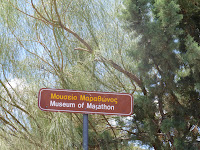We also performed another play here, about the mythology of the temple (or one version of it).
 |
| Joe lining up the cast |

ACT III: (which takes place after the sacrifice.. and after Act II which I can't really remember but involved Orestes killing his mother, Clytemnestra, and her lover, Aegisthus) Orestes is ordered by Apollo to go to Tauris, and his BFF Pylades tags along. While there, they get captured by the Tauri, who like to sacrifice their prisoners to Artemis. But lo and behold, the priestess of Artemis is dear old Iphigenia (which is his sister), but they don't recognize each other. Eventually they figure it all out, and the three of them escape together, and Iffy remains a priestess of Artemis Brauronia. THE END.
 After Brauron we went to Marathon and its museum there. We also got a chance to see the burial ground just outside of the museum, that they had placed a roof over (which was kind of cool/weird). Nobody but Kristine did any actual running (she even brought running shorts! Whatanerd :)
After Brauron we went to Marathon and its museum there. We also got a chance to see the burial ground just outside of the museum, that they had placed a roof over (which was kind of cool/weird). Nobody but Kristine did any actual running (she even brought running shorts! Whatanerd :) |
| Those Greeks are just so helpful! |
From there we had to rush to get to the tomb before it shut down, but it was only about a five minute bus ride from the museum. It didn't look like much, but it was still pretty impressive. Yes, that great, giant mound of dirt is indeed the archaeological site of the Marathon Tomb.
The Battle of Marathon took place in 490 BC, during the first Persian invasion of Greece, during an Athens vs Persia death battle. Even though the Persians had the numerical advantage, the Athenians were the victors. This tomb, though, is the final resting place of 192 Greeks who lost their lives in this battle.
The Marathon Run comes from the story of an Athenian runner named Pheidippides, who was sent from Athens to Sparta to ask for help, covering a distance of 140 miles in just two days. Goddamn lil' mama!




0 comments:
Post a Comment